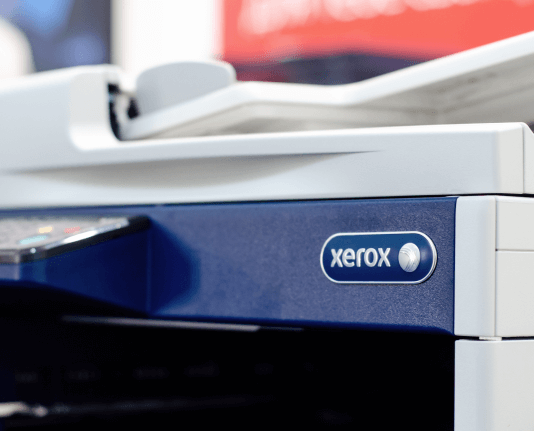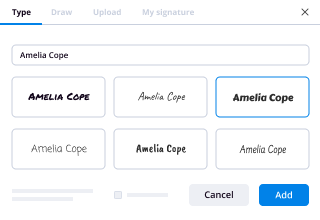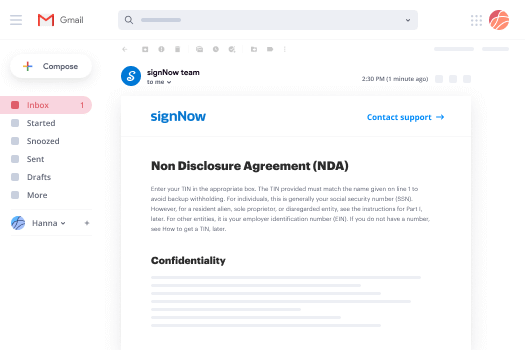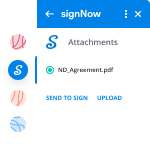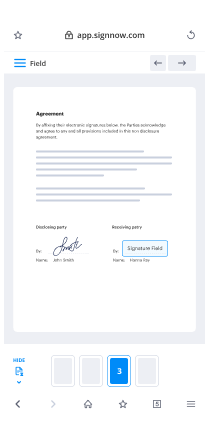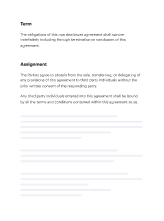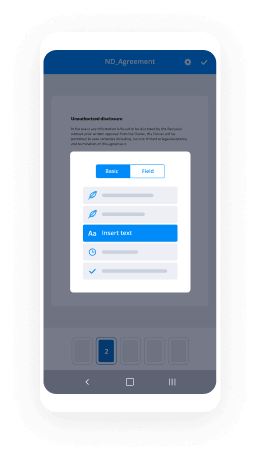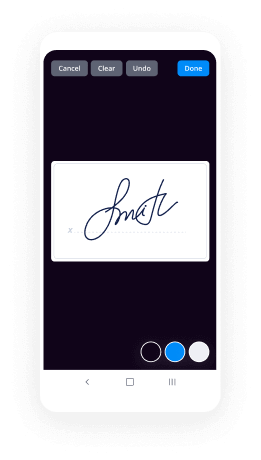How To Electronic signature Form for Legal
Make the most out of your eSignature workflows with airSlate SignNow
Extensive suite of eSignature tools
Robust integration and API capabilities
Advanced security and compliance
Various collaboration tools
Enjoyable and stress-free signing experience
Extensive support
Keep your eSignature workflows on track
Our user reviews speak for themselves






Advantages of utilizing an electronic signature form
In the current digital era, employing an electronic signature form is vital for optimizing document handling and boosting business productivity. airSlate SignNow provides an intuitive platform that enables organizations to send, sign, and oversee documents effortlessly. This guide will lead you through the straightforward steps to utilize airSlate SignNow for your electronic signature requirements.
Step-by-step guide for utilizing an electronic signature form with airSlate SignNow
- Launch your web browser and go to the airSlate SignNow homepage.
- Set up a free trial account or log into your current account.
- Choose the document you want to sign or send for signatures and upload it.
- If you intend to use this document regularly, convert it into a reusable template.
- Open your uploaded file and tailor it by adding fillable fields or inserting necessary details.
- Include your signature and specify signature fields for other signers.
- Click 'Continue' to complete and send the invitation for e-signature.
By adhering to these uncomplicated steps, you can efficiently manage your documents and signatures with airSlate SignNow. Its extensive features and user-friendly interface make it a signNow asset for any organization.
Don't pass up the chance to improve your document management workflow. Begin your free trial today and discover the advantages of airSlate SignNow firsthand!
How it works
Rate your experience
-
Best ROI. Our customers achieve an average 7x ROI within the first six months.
-
Scales with your use cases. From SMBs to mid-market, airSlate SignNow delivers results for businesses of all sizes.
-
Intuitive UI and API. Sign and send documents from your apps in minutes.
A smarter way to work: —how to industry sign banking integrate
FAQs
-
What is an electronic signature form?
An electronic signature form is a digital document that allows users to sign electronically, providing a secure and efficient way to execute agreements. With airSlate SignNow, you can create and send electronic signature forms that streamline your signing process, making it easier to manage documents online.
-
How does airSlate SignNow ensure the security of electronic signature forms?
airSlate SignNow prioritizes security by using advanced encryption technologies to protect your electronic signature forms. Additionally, each signed document is securely stored and can be accessed only by authorized users, ensuring compliance with legal standards and safeguarding sensitive information.
-
What features does airSlate SignNow offer for electronic signature forms?
airSlate SignNow provides a range of features for electronic signature forms, including customizable templates, real-time tracking, and mobile signing options. These features enhance the user experience and help you manage your documents more effectively, whether you're in the office or on the go.
-
Is there a cost associated with using electronic signature forms through airSlate SignNow?
Yes, airSlate SignNow offers various pricing plans to accommodate different business needs. You can choose a plan that includes access to electronic signature forms, along with additional features such as document storage and team collaboration tools, all at a competitive price.
-
Can I integrate airSlate SignNow with other applications for electronic signature forms?
Absolutely! airSlate SignNow seamlessly integrates with numerous applications, allowing you to connect your electronic signature forms with tools you already use. Whether it's CRM systems, cloud storage, or project management software, these integrations enhance workflow efficiency and document management.
-
How can electronic signature forms benefit my business?
Using electronic signature forms can signNowly reduce the time and resources spent on document signing and processing. By streamlining the signing process with airSlate SignNow, your business can improve productivity, reduce paper waste, and enhance overall customer satisfaction.
-
Are electronic signature forms legally binding?
Yes, electronic signature forms created through airSlate SignNow are legally binding and compliant with laws such as the ESIGN Act and UETA in the United States. This means your signed documents hold the same legal standing as traditional handwritten signatures, offering peace of mind for your business transactions.
-
How can we send forms via electronic-mail and make it legal without a normal hand-written signature?
I would look to getting an app which specializes in electronic signing. Here is a list of the 11 best electronic signature apps, courtesy of HubSpot. 1. signNow 2. signNow 3. signNow 4. signNow 5. eSignLive 6. SignNow 7. signNow 8. signNow 9. signNow 10. signNow 11. signNow
-
How valid is a PDF document that I signed on my computer (image of my signature) vs my actual signature on the printed document?
Although every state has passed laws that involve e-signatures, under the federal ESIGN Act, your electronic signature on a .pdf is just as valid as your physical signature. The ESIGN Act provides that a contract or signature “may not be denied legal effect, validity, or enforceability solely because it is in electronic form.” This simple statement means that electronic signatures and records are just as good as their paper equivalents, and therefore subject to the same legal scrutiny of authenticity and burden of proof standards that apply to paper documents. So unless your signature was forged, given under duress, or you refused to sign via electronic means (or there's some other reason to invalidate the contract), the executed .pdf copy may be enforced against you.
-
Are the mobile signatures used in Square, PayPal and Flint payment apps legally binding?
In all 50 states and territories of the US "Electronic Signatures" are viewed as enforceable and binding to all parties to the agreement(s). The electronic facsimile of a cardholder's signature is not just an artifact of Flint, but also of Square, PayPal and other mobile payment companies. You will also witness signature pads at all large retailers in the US.The First Electronic Signature Was Morse CodeThe case law signNowes back to the 1850s in the US where Morse Code was transmitted via Telegraphy [1].Saturday, June 10th, 1871, Samuel F. B. Morse sending his last telegraph message, his signature: "S ... F .-. B -... M -- O . . R . .. S ... E ." to a standing ovation.1869 And The First Legal Test Of An Electronic SignatureIn 1869 the New Hampshire Supreme Court decided a case that challenged if a telegraphed contract was valid. In the findings:"It makes no difference whether that operator writes the offer or the acceptance, with a steel pen an inch long attached to an ordinary penholder, or whether his pen be a copper wire a thousand miles long. In either case the thought is communicated to the paper by the use of the finger resting upon the pen; nor does it make any difference that in one case common record ink is used, while in the other case a more subtle fluid, known as electricity, performs the same office."This ruling has formed the foundation in US law all the way up to the Facsimile machine and the current finger signatures that are common to the current smartphone payment apps. The US codified the law more clearly in the E-Sign Act ( the Electronic Signatures in Global and National Commerce Act} from 2001 [2]. This expands upon the prior Uniform Electronic Transactions Act (UETA) [3].The E-Sign Act states:(a) IN GENERAL.—Notwithstanding any statute, regulation, or other rule of law (other than this title and title II), with respect to any transaction in or affecting interstate or foreign commerce—(1) a signature, contract, or other record relating to such transaction may not be denied legal effect, validity, or enforce- ability solely because it is in electronic form; and(2) a contract relating to such transaction may not be denied legal effect, validity, or enforceability solely because an electronic signature or electronic record was used in its formation.A Payment Card Transaction Is A Signed ContractA Payment Card transaction is a contract between the cardholder and the card issuing bank and indirectly the merchant. When a cardholder authorizes a bank for the use of a Payment Card they are also authorizing your approval of all transactions with or without a signature. Thus at the very least there is cardholder authorization for a transaction that was conducted using an Electronic Signature regardless of the E-Sign Act. But with the E-Sign Act the mark would be considered valid unless the cardholder contests or otherwise repudiates the transaction. This would be considered a Chargeback and it is another thing entirely (see: Brian Roemmele's answer to How do you prevent people from using chargebacks as a method for refunds?).Apple And A New IOS "Home Button", A Finger Print Electronic Signature SystemThe electronic signature will continue to evolve. In the future other unique identifiers will be used to confirm or authorize a payment card transaction. Look for Apple to release an integrated fingerprint scanner (for a multitude of reasons) in to new IOS devices that can be used as an electronic signature to confirm and authorize payment card transactions (see: Brian Roemmele's answer to Why did Apple buy AuthenTec?). This feature will form the basis of Apple's new iWallet and extension to Passbook. Image from the 2008 Apple patent 20100082444 showing NFC Logo and fingerprint scanner (using the older AuthenTec thin rectangular finger print scanner AES2750). I believe the actual fingerprint scanner will be the Home Button using another AuthenTec product. A long JourneyThe electronic signature has come a very long way from the days of Mr. Morse's invention. However the intent continues to perform the same basic human function, I authorize and confirm this contract.___1) Privacy Issues In Federal Systems:2) Page on Gpo3) Uniform Electronic Transactions Act
-
What are some of the legal hurdles around creating a startup in the legal domain?
We were lucky to have the background and experience to get through legal issues without much drama - but some of the legal issues that have come up are (in no particular order):Finding and developing good legal formsRegistering as a document preparation serviceMaking sure you don't engage in unauthorized practice of law (which is what LegalZoom has been sued for a few times)Along the same lines, making sure that people understand you're not offering legal services, just software that makes it easier for others to get legal stuff doneIf you're doing electronic signatures, complying with the major electronic signature regulations (US and EU)If you're doing anything involving government, figuring out which agencies accept electronic signatures and for what purposes (ESIGN act has an exception for government entities so that they can decide when to accept electronic signatures and when not to)Along the same lines, figuring out how to interface with government agencies from a logistical standpointProbably forgetting a few, but those are the ones I remember!
-
How do digital signatures and electronic signatures differ?
Many people think that electronic signatures are the same as digital signatures but that is not the case. In fact, digital signatures are a highly secured way to implement electronic signatures.Digital signatures use a public and private key generation framework, signature algorithm and a verification algorithm to match public and private keys and validate the authenticity of electronic signatures.Ever since the passing of the E-Sign Act in 2000, electronic signatures have acquired as much weight as the traditional wet or ink signature. As a result, electronic signatures have become widely used to conduct business online. This term is quite broad however, and not all electronic signatures constitute as digital signatures, which are guaranteed to fulfill the requirements decreed by the E-Sign Act. These terms include:– The customer’s intent to sign, as well as the consent to sign electronically– The software’s ability to maintain document integrity through unique identifiers– The company’s responsibility to retain all documents for legal purposesWhat does it mean? In a nutshell, every document requiring a digital signature has, in effect, a unique key attached to it. This is done using a public key infrastructure (PKI). Public key is generated & attested by the operator of the PKI called a Certificate Authority, and is held by the document owner, who can then pass on copies to his or her clients. Once the client signs, a unique key (private key) message becomes embedded inside the document. If anyone tries to tamper with the document, the software algorithm will detect it and invalidate the document.Due to increased identity theft in recent years, it has become ever more important for documents to be signed under a watchful eye, whether that be through digital or in-person witnesses. Companies that value your security will enact several layers of protection to ensure that every document is using digital signatures and is legally secure. At signNow, we use industry-standard encryption, time stamps, in-document visibility control, and e-mail authentication to discourage electronic forgery. signNow complies with the E-Sign Act, as well as UETA, HIPAA, and more.
-
Will electronic signatures on contracts hold up in a court of law?
That depends on what exactly you mean by an "electronic signature", and the type of contract that you're trying to enforce. Generally, the fact that a signature is electronic instead of a physical mark is not sufficient for it to be outright ignored by the law. In fact, the Uniform Commercial Code (UCC) explicitly allows for the validity of electronic signatures (something I covered in length on Are digital signatures via iPhone/iPad recognized as legally binding?):§ 1-201. General Definitions(39) "Signed" includes any symbol executed or adopted by a party with present intention to authenticate a writing. This is why an "X" on a contract is sufficient to count as a signature - it is a "symbol" that is "executed" by a party with "intent" to "authenticate" the contract.§ 2-211. Legal Recognition of Electronic Contracts, Records, and Signatures(1) A record or signature may not be denied legal effect or enforceability solely because it is in electronic form.(2) A contract may not be denied legal effect or enforceability solely because an electronic record was used in its formation.(3) This article does not require a record or signature to be created, generated, sent, communicated, received, stored, or otherwise processed by electronic means or in electronic form.(4) A contract formed by the interaction of an individual and an electronic agent under Section 2-204(4)(b) does not include terms provided by the individual if the individual had reason to know that the agent could not react to the terms as provided.This basically means that, just because the "signature" is in electronic format, it's entirely valid.§ 2-212. ATTRIBUTIONAn electronic record or electronic signature is attributable to a person if it was the act of the person or the person's electronic agent or the person is otherwise legally bound by the act.This allows you to have PayPal or some other third party or application to which you've assigned the power bind you to a contract.
-
How can I cash a personal check?
How can I cash a personal check? The first step to cashing a personal check is to endorse the check. That means signing your name (assuming the check is addressed to you) on the back of the check. There should be a line on the back of the check that says “endorse here”. Make sure not to write in the area that says “Do not write below.”Do not endorse the check until you are ready to complete one of the methods below to cash the check. Once you sign the check anyone can take it and cash it. So if you endorse it and then lose it, you are at risk of losing the money.Use your bank’s mobile app to deposit the check. This is the ...
-
How many of you know that electronic signatures are legally binding?
I’m not a lawyer, so this isn’t legal advice, however due to diligent research I personally believe it is safe to say that yes, they are provided that the signer understand that they are signing the document and acknowledge that it is in fact them who is “signing” it. If the identity of the signer was in question, the document would need to be signNowd, which would not be able to be an electronic signature. It would be easy to assume that any electronic signature could therefore not be the person signing it. However, regular paper forms could also be signed by someone else other than the person who is supposed to be signing them, as well. It would have to be signNowd, which again, can only happen with regular paper, because the notary, when they signNow a document, they are identifying the signer as the person who is supposed to be signing it.But also, contracts do not have to be signNowd in order to be valid or enforceable, in which case, most documents signed online are practically contracts anyway.So basically, what I’m saying, is that although it seems that electronic signatures are not as legal or official, just remember that anything that can be done with a paper document can also be done with an electronic document (except be signNowd, it has to be paper, for that to happen).
-
Is electronic signature legally binding in India?
Yes, e-signatures are legally valid in India. In fact, e-signatures have been recognized by the Indian law, with the passage of the Information Technology Act in year 2000.As per the IT Act, two types of signatures have the same legal status as handwritten signatures. These primarily include:(i) Digital Signatures: In this case, the signer is issued a long-term (1 to 2 year) certificate based digital ID stored on a USB token that can be used along with a personal PIN to sign a document.Note: Previously, the signer was issued a long-term (1 to 2 year) certificate based digital ID stored on a USB token that could be used along with a personal PIN to sign a document digitally. Now with Aadhaar, that complicated procedure isn’t required anymore. You can simply use signNow’s Aadhaar eSign to create a digital signature on the fly using your Aadhaar ID(ii) Electronic signatures: These electronic signatures combine Aadhaar identity number with an electronic Know-Your-Customer (eKYC) method (which includes sending an One-Time-Passcode to the mobile number linked to the Aadhaar card for verification)These Aadhaar based e-signatures and digital signatures are valid as long as they satisfy these conditions:(i) Electronic signatures must be uniquely linked to the person signing the document. (in the case of Aadhaar based signatures, they are linked by the unique Aadhaar ID)(ii) At the time if signing, the signatory must have control over the data used to generate the electronic signature (for eg: they should be able to directly affix the electronic signature to the document)(iii) There should be an audit trail of the steps taken during the signing the process(iv) In the case of digital signatures, signer certificates must be issued by signNowing Authority recognized by the Controller of signNowing Authorities appointed under the IT Act.Few of the exceptional cases in which documents cannot be signed electronically and must be executed using traditional handwritten signatures include:(i) Negotiable instruments such as a bill of exchange or a promissory note(ii) Powers of attorney(iii) Trust deeds(iv) Wills and any other testamentary disposition(v) Real-estate contracts such as leases or sales agreements.If you are looking to get legally compliant electronic signatures on contracts, invoices, quotes etc., try signNow, India’s first Aadhaar eSign solution that offers a complete fill-and-sign functionality with business workflows. Thus allowing users to finish their documents in one go.Here’s an informative ebook that will give you a brief overview of everything you need to know about electronic signature laws in some of the largest economies around the world: The Complete Guide to Electronic Signature Laws
Trusted esignature solution— what our customers are saying
Get legally-binding signatures now!
Related searches to How To Electronic signature Form for Legal
Frequently asked questions
How do i add an electronic signature to a word document?
How to scan and save an electronic signature?
How the hell do i esign a webpage?
Get more for How To Electronic signature Form for Legal
- How To eSign Texas Affidavit of Title
- How Do I eSign Texas Affidavit of Service
- eSign California Cease and Desist Letter Online
- eSign Colorado Cease and Desist Letter Free
- How Do I eSign Alabama Hold Harmless (Indemnity) Agreement
- eSign Connecticut Hold Harmless (Indemnity) Agreement Mobile
- eSign Hawaii Hold Harmless (Indemnity) Agreement Mobile
- Help Me With eSign Hawaii Hold Harmless (Indemnity) Agreement
Find out other How To Electronic signature Form for Legal
- Masonry work contract template form
- Massage contract template form
- Massage membership contract template form
- Master builders contract template form
- Master grower contract template form
- Master of ceremony contract template form
- Material supply contract template form
- Master service contract template form
- Maternity cover contract template form
- Maternity leave contract template form
- Maternity leave replacement contract template form
- Maternity leave cover contract template form
- Maternity photography contract template form
- Matrix contract template form
- Maximum term contract template form
- Meal prep contract template form
- Mean contract template form
- Mechanic work contract template form
- Mechanic contract template form
- Media agency contract template form

